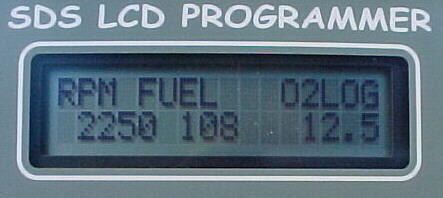
Last updated 05/22/18
O2 Logging
This is a built in feature in SDS for capturing the air/fuel ratio in each RPM range for tuning automotive systems. Logged readings are stored in RAM (memory) and are then displayed in each RPM FUEL range window. If you see that the O2 logged reading is too rich or lean in a range, then you can change that rpm fuel value.
Logging with Wideband or Standard O2
O2 logging requires that the SDS gray wire is connected to either a standard heated or unheated O2 sensor, or for best results, a wideband A/F meter. V16+ software supports AEM, Autometer, PLX, Innovate and WMS units. A standard O2 sensor will work adequately, but standard O2 sensors do not give accurate readings in the rich region.
O2 Type
This is for selecting which type of O2 sensor. Proper selection is important in order for closed loop and O2 logging to operate properly.
There are 4 selections with V16- NONE, STANDARD, WIDE WMS 0-5V for WMS, Innovate and WIDE AEM 0-5V for AEM, Autometer and PLX. When set as STANDARD, Gauge3 mode will not display A/F ratio, but instead will display O2 voltage.

Press +1 or -1 to change.
Hookup:
Standard O2 sensor: connect the 20Ga gray wire in the SDS main harness to the signal wire on the O2 sensor.
PLX grey wire to SDS grey wire. 14.7 brand- green wire to SDS grey wire.
How this works:
O2 logging begins automatically whenever the throttle position is greater than position 20. There is nothing to turn on or enable. Use Gauge 3 mode to see the current throttle position.
As the engine enters each new rpm range, several samples of O2 voltage are taken and the average of these samples are held in RAM. Then as you scroll through the RPM FUEL values, the logged readings are displayed on the right hand side of the LCD programmer display.
Tips for best use:
The engine should be warmed up to normal running temperature before observing results.
O2 logging will work well if the O2 sensor is placed within 3 feet/1 meter of the engine. Placement further than this may cause delayed readings and RPM fuel values affecting the O2LOG.
Reading in the next highest RPM range, but logging will still be useful.
Throttle should be held quite stable to give repeatable accurate results, since unsteady throttle will trigger the ACC PUMP feature, which adds extra fuel.
O2 logging should be done in 3rd or 4th gear so that RPM's are not increasing too rapidly. O2 logging may not occur if engine rpm's increase too rapidly, so logging in neutral, 1st and 2nd gear may result in no data logged due to very quick engine acceleration.
On the first attempt of O2 logging, ranges that are not logged show --.- in the display(wideband) and .0V(standard O2). Old data will remain in the computer until it is overwritten by new data, and if not enough samples are gathered in any particular rpm range, then old logged data will still be displayed from a prior run.
Currently there is only one way to erase logged O2 data, and this is done by turning off power to the SDS computer. Remember to view O2 data before turning off the engine, since O2 logged data is only held in RAM and will be lost when power is shut off to SDS. After reviewing logged data, it may be a good idea to power down the SDS momentarily to clear out all logged data before attempting the next run of the engine.
Correcting the Mixture Using a Wideband Meter:
If O2LOG readings are leaner than 14.0 at full throttle and or high RPM, then fuel numbers should be increased to richen the mixture.
Once O2 data is logged, the Air/Fuel ratio is likely not what you desire, so changes must be made. Simple math using the following formula will give a correction factor to get the desired Air/fuel ratio.

Correction = Logged A/F divided by desired A/F
Example #1: At 3250 RPM say, we have an RPM FUEL value of 108. The O2LOG shows an A/F ratio of 14.7, but we would like to make the A/F ratio 13.5.
Correction=14.7/13.5
Correction= 1.09.
Now we multiply the RPM FUEL value by 1.09.
108 x 1.09=117.7. Round off to 118.
Example #2: At 3250 RPM say, we have an RPM FUEL value of 108. The O2LOG shows an A/F ratio of 12.5, but we would like to make the A/F ratio 13.5.
Correction=12.5/13.5
Correction= 0.93
Now we multiply the RPM FUEL value by 0.93.
108 x 0.93=100.44. Round off to 100.
With a wideband sensor, best power will occur with an A/F ratio of 12.5:1 to 13.0:1.
Correcting the Mixture Using a Standard O2 Sensor:
Testing with a single wire GM O2 sensor shows maximum power with O2 voltages of approximately .76 or higher. If O2 logged voltage is less than .60V then fuel values should be increased for best fuel mixture and maximum power. Logged voltage of .50 is equivalent to 14.7 A/F ratio, so to arrive at a 13.0 A/F, you can multiply the fuel value by 1.13.

On Turbo Engines:
RPM FUEL values should be adjusted at lowest boost pressure setting. If you then raise boost to higher pressure, and need to change the A/F ratio, you can multiply the correction on the MANIFOLD PRESSURE fuel value instead of RPM FUEL, so this way you only affect mixture at these higher boost pressures.
01/05/05 Update
The images below show the programmer display after an actual data log run with the WMS wideband:










